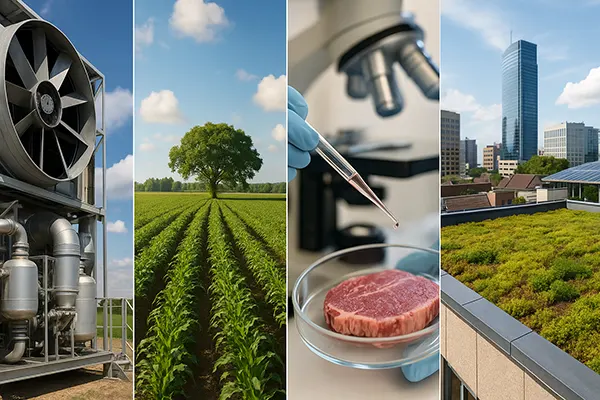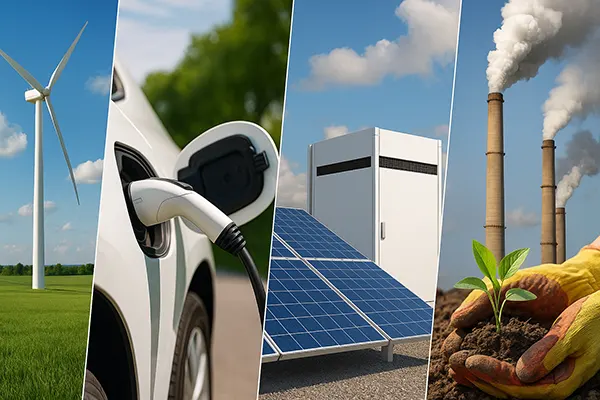
Climate Startups: Technologies That Truly Cool the Planet
The urgency to tackle climate change has never been greater. As global temperatures continue to rise and ecosystems falter, climate technology startups have stepped into the spotlight. These ventures aren’t just dreaming of a greener future — they’re building it now. Below, we explore the most impactful solutions from innovative companies actively fighting the climate crisis in early 2025.
Direct Air Capture: Removing Carbon from the Atmosphere
Direct Air Capture (DAC) has evolved from a theoretical concept to a functional climate tool. Startups like Climeworks and Heirloom are deploying DAC units across Europe and North America. These machines extract CO₂ directly from the air and either store it underground or use it in products like concrete, helping achieve net-negative emissions.
Climeworks opened the world’s largest DAC plant in Iceland in late 2024. The facility captures over 36,000 tonnes of CO₂ annually, powered entirely by renewable geothermal energy. In the United States, Heirloom has refined a process that uses limestone and renewable energy to absorb carbon at a lower cost and with a smaller footprint.
While scalability remains a hurdle, the integration of DAC into government net-zero plans is progressing. Tax incentives in the US and EU subsidies are accelerating adoption. Climate funds and corporate net-zero commitments have helped inject billions into the sector, signalling a promising trajectory for DAC startups.
Innovation Driving Costs Down
One of the critical challenges in DAC has always been the cost — historically around $600 per tonne of CO₂. In 2025, this figure is steadily declining thanks to technological innovations and economies of scale. Startups are experimenting with modular units, more efficient sorbent materials, and co-location with renewable energy hubs.
Companies like Noya are retrofitting existing cooling towers in industrial settings to double as DAC units. This reduces infrastructure costs and accelerates deployment. Such innovations are key to making DAC a viable part of global decarbonisation strategies.
The ultimate goal remains carbon removal at less than $100 per tonne. Reaching this benchmark would unlock large-scale purchases from governments and corporations alike, shifting DAC from pilot projects to mainstream climate infrastructure.
Alternative Proteins: Rethinking Food Systems
The livestock industry accounts for around 14.5% of global greenhouse gas emissions. Climate tech startups have responded with groundbreaking alternatives — lab-grown meat, microbial proteins, and plant-based innovations. In 2025, these foods are no longer niche but increasingly accessible on supermarket shelves.
Companies such as Meatable (Netherlands) and UPSIDE Foods (US) are scaling cultured meat production using bioreactors. Meanwhile, Finnish startup Solar Foods produces “Solein,” a protein derived from CO₂, water, and electricity via fermentation. It’s carbon-neutral, nutritious, and ready to replace traditional animal protein in processed foods.
Consumer perception is rapidly evolving. Studies in early 2025 indicate that over 40% of Gen Z and Millennials in Europe are actively reducing meat consumption for environmental reasons. Governments are also stepping in, with Singapore and Israel approving more cell-based products for public sale.
Economic and Ecological Benefits
Switching to alternative proteins significantly reduces land use, water consumption, and methane emissions. Compared to beef, cultivated meat uses up to 95% less land and emits 80% fewer greenhouse gases. The ecological case is clear.
Economically, the cost of producing lab-grown meat has dropped by over 70% since 2020. Continued investment and scaling of production facilities are pushing prices closer to parity with traditional meat. With strong investor interest, this sector is likely to reach mass market viability within the next few years.
Governments and climate finance bodies are increasingly backing food innovation as a key emissions lever. If integrated into national climate plans, alternative proteins could account for 10–15% of total required emissions reductions by 2035.

Cool Roofs and Passive Urban Cooling
As cities heat up due to urbanisation and climate change, passive cooling technologies have become essential. One simple yet powerful innovation is the “cool roof” — a roof coated with highly reflective material that reduces building heat absorption and lowers energy demand for air conditioning.
Startups such as Antora and Radi-Cool are deploying radiative cooling materials that reflect sunlight while emitting heat into space, even under direct sunlight. This technology can cool surfaces below ambient air temperature without consuming energy — a game-changer in hot climates like India and the Middle East.
Additionally, passive cooling is being integrated into new building codes. Cities like Los Angeles and Dubai have already implemented regulations requiring reflective or green roofs on new developments. These measures not only cut emissions but also reduce heat-related health risks for urban populations.
Scalability and Local Impact
The simplicity and cost-effectiveness of cool roof coatings make them particularly suitable for rapid deployment in developing regions. A reflective coating can reduce indoor temperatures by 5–10°C, significantly improving living conditions in informal settlements.
Several climate startups are partnering with NGOs and municipal governments to roll out cool roof projects in cities across Latin America, Southeast Asia, and sub-Saharan Africa. In many cases, these programmes are supported by international climate funds and green bonds.
Though not a silver bullet, passive cooling solutions represent an immediate and practical intervention. When combined with broader urban greening efforts and building decarbonisation, they form a crucial part of the short- and medium-term climate mitigation toolkit.




